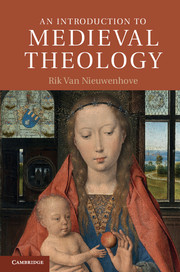Book contents
- Frontmatter
- Contents
- Abbreviations
- Chapter 1 Introduction
- Part I The legacy of the Fathers
- Part II Early medieval theologians
- Part III The eleventh and twelfth centuries
- Part IV The thirteenth century
- Part V The fourteenth century and beyond
- Chapter 17 Introduction
- Chapter 18 William of Ockham
- Chapter 19 Meister Eckhart
- Chapter 20 Jan van Ruusbroec and the Modern Devotion
- Chapter 21 Epilogue
- Bibliography
- Index
- References
Chapter 17 - Introduction
- Frontmatter
- Contents
- Abbreviations
- Chapter 1 Introduction
- Part I The legacy of the Fathers
- Part II Early medieval theologians
- Part III The eleventh and twelfth centuries
- Part IV The thirteenth century
- Part V The fourteenth century and beyond
- Chapter 17 Introduction
- Chapter 18 William of Ockham
- Chapter 19 Meister Eckhart
- Chapter 20 Jan van Ruusbroec and the Modern Devotion
- Chapter 21 Epilogue
- Bibliography
- Index
- References
Summary
Undoubtedly, the fourteenth century was a period of major turmoil. The political scene was dominated by the conflict between France and England (the Hundred Years’ War (first phase: 1337–96)). In economic terms, Europe faced stagnation, leading to starvation (in 1315–1317), insurgencies in the countryside (e.g., in Flanders in 1323–28; French Jacquerie of 1358; England in 1381) and urban rebellions in Ghent (Artevelde, 1338) and Florence (Ciompi, 1378). To make matters worse, the Black Death struck in 1348–51, wiping out an estimated one third of the population.
The papacy, too, faced major crises throughout the century. The main problem was the struggle for power with the new Nation States, especially France. When Philip the Fair (d. 1303) effectively took control of the French Church, Pope Boniface (1294–1303) could only make futile claims that the secular power should be subordinated to the spiritual power of the successor of St. Peter. A major debate raged throughout the century on the relation between secular and spiritual power. Giles of Rome (De Potestate Ecclesiastica from 1301) and James of Viterbo (d. 1308) supported papal claims; John of Paris (d. 1306), William of Ockham (d. 1347) and above all Marsilius of Padua (d. 1343), who wrote an influential treatise on politics, Defensor Pacis, disputed the papal claims. The influence of the French crown on the papacy became painfully evident during the so-called “Babylonian Captivity” when the Popes resided in Avignon. This exile ended in 1377 when Pope Gregory XI returned to Rome. A year later worse was to follow. In 1378, French cardinals declared that their election of Urban VI in Rome had been coerced by the Roman populace, and was therefore invalid. They then proceeded to elect a cousin of the French king as rival pope Clement VII (d. 1394). This situation would only be solved in the second decade of the fifteenth century by the Councils of Pisa and Constance (1417). The embarrassment of the schism and the decline of papal influence it entailed led to heated discussions as to how papal power should relate to that of the Councils. Conciliarism, although no longer influential in real terms after 1440, must rank as one of the most important expressions of a more general movement towards representative government in Europe in the late-medieval period.
- Type
- Chapter
- Information
- An Introduction to Medieval Theology , pp. 249 - 252Publisher: Cambridge University PressPrint publication year: 2012

